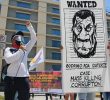By CHERYLL D. FIEL | Davao Today
Related story: Fears raised against Balikatan
A day before the joint U.S.-Philippine Balikatan military exercises, young Moro protesters led a barricade in barangay Sarimanok in Marawi City, which ended up with protesters hurling stones at a passing convoy of vehicles loaded with U.S. soldiers.
Not contented, the protesters chased the fleeing Hi-Ace and Toyota vans and hit the car windows with stones.

Abdurahim Ammalun (davaotoday.com photo by Jonald Mahinay)
Aida Ibrahim, chair of the Moro youth organization Liga ng Kabataang Moro (LKM) in Marawi said the Moro youth will do everything they can to drive the U.S. troops away.
The U.S. Embassy announced that the U.S. troops are in Central and Western Mindanao from February 18 – March 3 on “humanitarian mission” to build bridges, repair schools and other community infrastructures; and to give people medical, dental check-ups and even veterinary care, for free.
But the US Embassy statement fails to appease the young Moro protesters.
“We in Lanao fear that the Balikatan might trigger war again,” said another young Maranao, Fahad Macarimbor.
Three years ago, Macarimbor saw the massive evacuation of Moro residents in the nearby Kauswagan town in Lanao del Norte during the military operation with the Moro Islamic Liberation Front (MILF), a revolutionary group fighting for an independent Islamic state in Mindanao.
He said he heard that more soldiers died than the MILF fighters and a lot of civilians were forced to leave their homes. “Some even refused to return out of fear,” Macarimbor recalled.
“We all know that Moro revolutionary groups are present in these areas. What if the US military men would encounter these troops?” he asked.

Naida Bellecina (davaotoday.com photo by Jonald Mahinay)
Macarimbor said that even the peace talks could not allay people’s fears. “We know that the peace talks between the MILF and government are going nowhere. How can it be an assurance?”
Amirah Ali Lidasan, secretary general of the Suara Bangsamoro (Voice of the Moro People) said this fear could be traced to the experiences of residents in areas in Mindanao in the previous Balikatan exercises.
Lidasan cited that there had already been instances in the past where the presence of U.S. soldiers sparked gun battles in areas where Moro revolutionary groups exist, such as what happened in Sulu in November 2005.
She said that in this incident, U.S. and military troops engaged in combat operations right inside a known base camp of the Moro National Liberation Front (MNLF), which caused tension between soldiers and the Moro revolutionary group, which signed a peace agreement with the Philippine government in 1996.
Lidasan said the likelihood of armed encounters between US troops and Moro revolutionary groups increases the already vulnerable security situation of residents.
“Besides, didn’t the US officials make a statement that they can fire at people whom they think will compromise their security?” Lidasan asked.
She also said that the portrayal of Moro people as “terrorists” also made it even worse.









